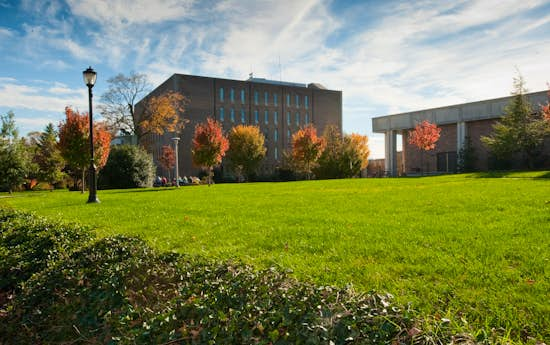713 results nationwide
List of 3.6 GPA Colleges
Displaying 713 colleges where your 3.6 GPA is within the typical range of past accepted students. You have a chance at being accepted but admission may be challenging at more selective colleges. Hint: Filter by admission chance for 2,025 target schools (good chance), 456 reach (harder) schools and 2,634 safety (easier) schools you can consider.
CUNY Hunter College
Public 4 Year
0 reviews
3.7 Average GPA
Public 4 Year
0 reviews
#10 Best Public Universities in New York
- 22,970enrollment
- $4,848net price
- 48%acceptance rate
- 1170-1340SAT range
- 25-31ACT range
Tulane University
Private 4 Year
1 reviews
3.64 Average GPA
Private 4 Year
1 reviews
- 14,027enrollment
- $50,263net price
- 11%acceptance rate
- 1370-1510SAT range
- 31-33ACT range
Applications Due Jan 15
The University of Texas at Arlington
Public 4 Year
3 reviews
3.43 Estimated Average GPA
Public 4 Year
3 reviews
#9 Best Public Universities in Texas
- 43,946enrollment
- $14,262net price
- 81%acceptance rate
- 1000-1240SAT range
- 18-26ACT range
Applications Due Jun 1
Western Carolina University
Public 4 Year
10 reviews
3.44 Average GPA
Public 4 Year
10 reviews
#10 Best Public Universities in North Carolina
- 11,635enrollment
- $13,022net price
- 85%acceptance rate
- 1020-1240SAT range
- 19-26ACT range
Applications Due Mar 1
West Chester University of Pennsylvania
Public 4 Year
0 reviews
3.43 Average GPA
Public 4 Year
0 reviews
#3 Best Public Universities in Pennsylvania
- 17,275enrollment
- $22,973net price
- 88%acceptance rate
- 1080-1260SAT range
- 23-30ACT range
North Carolina A & T State University
Public 4 Year
1 reviews
3.61 Average GPA
Public 4 Year
1 reviews
#15 Best Public Universities in North Carolina
- 13,487enrollment
- $9,189net price
- 56%acceptance rate
- 960-1140SAT range
- 17-23ACT range
Applications Due Jun 1
University of Rhode Island
Public 4 Year
5 reviews
3.58 Average GPA
Public 4 Year
5 reviews
#1 Best Public Universities in Rhode Island
- 17,473enrollment
- $20,695net price
- 76%acceptance rate
- 1050-1270SAT range
- 25-30ACT range
Applications Due Feb 1
Morehouse College
Private 4 Year
0 reviews
3.48 Average GPA
Private 4 Year
0 reviews
- 2,567enrollment
- $35,251net price
- 60%acceptance rate
- -SAT range
- -ACT range
Applications Due Feb 1
Illinois State University
Public 4 Year
4 reviews
3.41 Average GPA
Public 4 Year
4 reviews
#6 Best Public Universities in Illinois
- 20,683enrollment
- $20,551net price
- 86%acceptance rate
- 1000-1210SAT range
- 21-27ACT range
Applications Due Apr 1
University of Connecticut
Public 4 Year
2 reviews
3.74 Estimated Average GPA
Public 4 Year
2 reviews
#12 Best Public Universities in America
- 27,003enrollment
- $23,985net price
- 55%acceptance rate
- 1220-1440SAT range
- 28-33ACT range
Applications Due Jan 15
University of Oklahoma Norman Campus
Public 4 Year
2 reviews
3.66 Average GPA
Public 4 Year
2 reviews
#1 Best Public Universities in Oklahoma
- 28,308enrollment
- $22,601net price
- 73%acceptance rate
- 1130-1330SAT range
- 23-29ACT range
Applications Due Feb 1
Virginia Commonwealth University
Public 4 Year
1 reviews
3.75 Average GPA
Public 4 Year
1 reviews
#9 Best Public Universities in Virginia
- 28,082enrollment
- $21,294net price
- 91%acceptance rate
- 1030-1290SAT range
- 22-30ACT range
Applications Due Jan 18
Rhode Island School of Design
Private 4 Year
0 reviews
3.71 Estimated Average GPA
Private 4 Year
0 reviews
#2 Best Colleges in Rhode Island
- 2,620enrollment
- $39,800net price
- 17%acceptance rate
- 1340-1525SAT range
- 29-33ACT range
Applications Due Feb 1
Wayne State University
Public 4 Year
3 reviews
3.42 Average GPA
Public 4 Year
3 reviews
#5 Best Public Universities in Michigan
- 23,630enrollment
- $15,347net price
- 75%acceptance rate
- 1040-1260SAT range
- 21-28ACT range
Applications Due Aug 1
Emerson College
Private 4 Year
0 reviews
3.73 Average GPA
Private 4 Year
0 reviews
#21 Best Private Colleges in Massachusetts
- 5,891enrollment
- $51,432net price
- 43%acceptance rate
- 1250-1430SAT range
- 30-32ACT range
Applications Due Feb 20
University of Denver
Private 4 Year
0 reviews
3.72 Average GPA
Private 4 Year
0 reviews
#2 Best Colleges in Colorado
- 13,734enrollment
- $42,423net price
- 78%acceptance rate
- 1220-1400SAT range
- 28-32ACT range
Applications Due Jan 15
Colgate University
Private 4 Year
1 reviews
3.77 Average GPA
Private 4 Year
1 reviews
#3 Best Colleges in New York
- 3,141enrollment
- $27,074net price
- 12%acceptance rate
- 1410-1530SAT range
- 32-34ACT range
Applications Due Jan 15
Mississippi State University
Public 4 Year
0 reviews
3.58 Average GPA
Public 4 Year
0 reviews
#2 Best Value Colleges in Mississippi
- 22,649enrollment
- $15,364net price
- 75%acceptance rate
- 1070-1280SAT range
- 21-29ACT range
Applications Due Aug 1


















